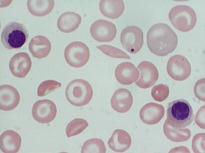Anemia occurs when the levels of healthy red blood cells (RBCs) in the body drop too low. This can lead to various health problems because RBCs contain hemoglobin, which is responsible for transporting oxygen to the body’s tissues. Anemia can cause various complications, including fatigue and stress on the body’s organs.
Anemia can be caused by various issues, but there are three main causes of anemia:
-
Excessive destruction of RBCs
-
Blood loss
-
Insufficient production of RBCs
 |
| Thalassemia is a severe form of anemia (Image: med-ed) |
Additionally, there are other causes such as genetic disorders, nutritional issues (like iron deficiency or vitamin deficiency), infectious diseases, certain types of cancer, or exposure to pharmaceuticals or toxins.
Anemia Due to Destruction of RBCs
Hemolytic anemia (“hemo” means blood, “lytic” means destruction) occurs when red blood cells are destroyed prematurely (normally, the lifespan of RBCs is 120 days. In hemolytic anemia, their lifespan is shorter) and the bone marrow (the soft, spongy tissue inside the bones that produces new blood cells) cannot keep up with the body’s demand for new cells. This can happen due to various reasons.
Occasionally, infectious diseases or certain medications like antibiotics or anticoagulants can also be causes of this condition.
In autoimmune hemolytic anemia, the immune system mistakenly identifies RBCs as foreign invaders and begins to destroy them.
In some children, genetic defects in red blood cells lead to anemia. Common forms of hereditary hemolytic anemia include sickle cell anemia (often seen in severe hereditary anemia), thalassemia, and glucose-6-phosphate dehydrogenase deficiency.
Sickle cell anemia is a severe form of anemia, commonly found in people of African descent, but it also affects individuals from Saudi Arabia, India, and the Mediterranean region. In this condition, hemoglobin forms long rods when it releases oxygen, transforming red blood cells into abnormal sickle shapes. This leads to early destruction of RBCs, lowering hemoglobin levels continuously, and causing recurrent pain as well as issues that can affect nearly every organ system in the body.
Thalassemia is a severe form of anemia: RBCs are destroyed rapidly, and iron accumulates in the skin and vital organs.
Glucose-6-phosphate dehydrogenase deficiency (G6PD) typically affects men of African descent, but it can also occur in many other groups. In this condition, RBCs either do not produce enough G6PD enzyme or produce an abnormal amount of G6PD that does not function properly. If someone is born with G6PD deficiency and then contracts an infection, takes certain medications, or is exposed to certain substances, the body’s RBCs can become overstressed. Without enough G6PD to protect them, many red blood cells will be destroyed prematurely.
Anemia Due to Blood Loss
Blood loss can also cause anemia, which may arise from losing too much blood due to injury, surgery, or issues with the blood-clotting ability. Chronic blood loss, such as bleeding from inflammatory bowel disease, can also lead to anemia. Sometimes, anemia can occur due to heavy menstrual bleeding (in girls and women). Certain cancers in children can also lead to aplastic anemia, which may be due to chronic diseases affecting the bone marrow’s ability to produce blood cells.
Anemia can also occur when the body cannot produce enough healthy RBCs due to iron deficiency. Iron is a crucial factor for producing hemoglobin. A diet low in iron can lead to iron deficiency, which is the most common cause of anemia in children. Iron deficiency anemia can affect children of all ages, but it is most commonly seen in those under two years old.
Girls who are in their teenage years are also at high risk for iron deficiency anemia due to menstruation, where monthly blood loss necessitates an increased intake of iron in their daily diet.
T.VY


















































